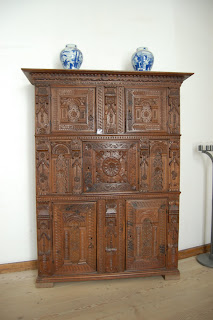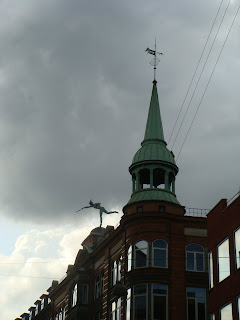8:30am. Wake up take two. This time prompted by alarm. Better start. I already had my bag packed, so before long I had checked out and was on my way back to the train station to put my things in a locker for the day. I still had some time before the train departed, so I went a few blocks over to a pastry shop I had seen the day before to indulge in a Danish pastry or two (which were ironically introduced to Denmark in the 1870s when Copenhagen breadmakers were replaced during strike by immigrant Viennese bakers).
I had a flight back to Vienna that night at 8:00 and had decided that I wanted to spend my final day in Denmark somewhere outside of Copenhagen. It was admittedly an improvisation I had made since getting to the city, and had spent the last two days polling locals on where they would go for a day trip. The top three recommendations were the chalk cliffs of Møns Klint, Helsingør and Kronborg Castle, and Malmö, Sweden. As tempted as I was to add Sweden to the list of countries I had been to, I figured half a day in a port town (although apparently a very charming one) was sort of cheating on that front. That, and as I was already in Denmark, I wanted to see more of Denmark. Møns Klint looked really scenic, but it was closer to two hours by train, and I would still have to get a bus from the station to the cliffs. Once at the cliffs, from what I could tell, there was a neat forest, Klinteskoven, with about 20 types of orchid flowering, but little in the way of a town or restaurants, and I figured what was around might have been closed that day because it was a national holiday. That left me with Helsingør. Also a charming little port town, its real claim to fame is Kronborg Castle. Not just another castle, I might add. In fact, Kronborg Castle is where Shakespeare set Hamlet (although he referred to the castle as Elsinore).
I stopped in at the tourist information desk on the way back to the station to see if they would double check that the castle would be open despite it being a holiday (I figured I would go to Malmö after all if that was the case - I love the flexibility of the Eurail pass!), and got the green light I was hoping for. Back at the station I jotted down the train information on my pass and hopped on board. An hour later we pulled into the station.
(I never thought that much about it, but I'm starting to draw the conclusion that I must really like train stations from all of the pictures of them that I've posted...)
Good thing I had written down the time for my best return option before I left, because there wasn't a train schedule anywhere to be found. My guidebook suggested that the best place to start one's tour of Helsingør is at Karmeliterklosteret Sankt Mariæ Kirke, the 15th century Carmelite Monastery and St. Mary's Church. H.C. Anderson certainly thought it was worth going, as he called it "one of the most beautiful spots in Denmark."
I was a disappointed to find that the church was locked, but the cloisters were still open, so I took a lap around there.
That was about the extent of what I could see there, though a quick sweep around the perimeter also led to the discovery of these nifty details:
I really wish I knew more about the second picture
The Helsingør Bymuseum was my next stop, but it was also closed, so I continued on to Sankt Olai Kirke which was built around 1200. Closed. Fine. I was getting hungry anyway. So I started roaming the streets a bit at random until I came across a promising looking place.
Now I know I was in a town with a good supply of fresh fish and that that should be the obvious choice for what to order, but I was really craving some frikadeller - Danish meatballs made of beef, veal, or lamb. They were just what I wanted, and surprisingly light considering they were meatballs. Also, if you ever find yourself in Helsingør, you can skim through this cafe's guestbook and see if you find my name.
From here I decided I would go see Marienlyst Slot and Kronborg Slot, where I figured I would spend the most of my remaining afternoon, and if there was time after I would check out the last few things in town that my guidebook considered worth seeing. Marienlyst Slot, originally built in 1587 and extensively remodeled as a Neo-Classical manor house from 1759 - 1763, was about a fifteen minute walk north of town. The gardens inside the castle wall were mostly intact, but I was sad to read that the most renowned romantic landscape garden in Denmark, which lay just outside the walls, was long gone. However, when I walked in the gate:
Alright, really? Was everything in Helsingør closed? Well, the tourist information center in Copenhagen had promised that Kronborg Slot was open (although the tourist information office in Helsingør was also closed), which was mainly what I was there to see, so I wasn't too put off by all of the other closures. I didn't walk out there for nothing, so I took a stroll around the grounds and got a really neat view of the sound from the hill behind Marienlyst Slot. There was also a park up there, and a mound with a prominent tombstone that with an engraving that looked to be a lion from the torso up and a seahorse/mermaid lower half that is known as Hamlet's Grave. By the way, if anyone knows what that mythical creature is, I'm really curious and couldn't find any information on it.
That was short-lived. Oh well, on to the highlight of my day: Kronborg Slot. The castle was out on a peninsula and surrounded by multiple motes, walls, and embankments known as the Crownwork. In 1658 the Swedish captured Kronborg, and this was constructed around the inner fortifications after being regained by the Danes. When seen from the air it resembles a traditional crown with three points, thus its name. Even before getting all the way inside I got distracted by a large tunnel which seemed to lead in the direction of the sea which cut though one of the hills, so I went to explore that. As I suspected, it lead out to the sound, and there was a cobbled pathway running around the shoreline.
Looking across to Sweden
It was quite warm out and the sea breeze was rather refreshing, so I took a turn around the perimeter which afforded me this view of Kronborg:
Eric of Pomerania built Krogen, a fortress on the same site - the narrowest section of the strait, in the 1420s to help enforce his demands of sound dues for any ship that wished to enter or leave the Baltic Sea as this was the main route (and one of only three; the other two passed through the middle of Denmark and also collected tolls) for ships to travel. It was rebuilt as Krongborg in 1585, though it burned in a fire in 1629; despite being restored the interior apparently never quite regained its former glory.
After circling back around I passed through more than one gateway to enter the castle's courtyard.
Where the well stands now supposedly used to be the site of a magnificent fountain, but that was carried off by the Swedes after they captured Kronborg. Once inside the castle I toured the royal apartments and other various rooms. The tour passed through this bedroom,
which was used as the princess' bedroom. As I passed through I heard occasional giggling. No one else was in the room with me, though. I moved back towards the first entrance near the bed and listened. Nothing. As I walked off I heard it again. This time some other people were entering the room and they definitely also heard it, so I wasn't imagining things. Yes, in fact there were speakers set up out of sight behind the bed with a sound track of a male and a female giggling on repeat. Interesting choice of location for such a thing. I wonder what that implied...
There were other treasures throughout, of course,
including a particular tapestry woven in 1550... Look familiar? Albrecht Dürer did a woodcut in 1515 based on a description of the first rhinoceros in Europe since Roman times, though he never actually saw it. Although the woodcut resides in the British Museum in London, you may have seen an ink drawing of it in the room behind the Winter Garden in the Biltmore (the room also houses a large portrait of Richard Morris Hunt).
Probably the most famous room in the castle is the Ballroom and Great Hall.
This was the largest royal hall in all of Northern Europe at the time of completion, measuring at 62 x 12 meters. Although it wasn't filmed here, the floor and the vast hall look strikingly similar to that in the 1996 film version of Hamlet with Kenneth Branagh and Kate Winslet. I wouldn't mind going to a ball here, even despite having two left feet.
The tour also included the chapel, the only part of the castle not to burn in the 1629 fire, so you can still get a sense of how ornate it once was. Oh, did I mention that for about 150 years Kronborg was used as a prison? The furniture was removed at that time, but it was all returned and is still complete with the same intricately carved oak benches and organ from the 18th century.
My last stop in the castle was a tour through the gloomy casements below the castle. They're quite vast and not uncommonly completely black (you could opt to buy a flashlight at the entrance). Instead I more or less successfully used the glow from my cell phone and flash from my camera to keep from running into walls or falling into pits.
There's a large statue of Holger Danske down there as well. Legend has it that should Denmark ever be in peril, the Viking chief will stir from dormancy and protect his kingdom.
This concluded my tour of Kronborg (or at least the part that I had paid for), and it was getting to be within the hour of the departure of my train back to Copenhagen, so I ventured back to Helsingør. With still a little time to spare I detoured to Axeltorv, the main square, a lively little area with restaurants and bars.
There's also a statue depicting Eric of Pomerania, and to continue with the earlier background on him, after he was dethroned in 1439 with the breakup of the Kalmar Union, he was reported to have moved to the Swedish island of Gotland where he took up piracy as a hobby.
I had another pastry while there, then caught my ride back to Copenhagen, picked up my bags, and continued on to the airport via rail. Flew back to Vienna, and was in my room again before the clock struck midnight.


















































